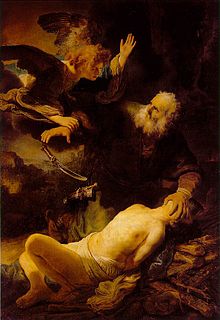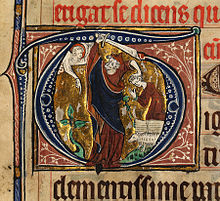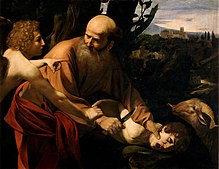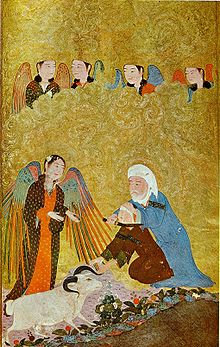Binding of Isaac
The Binding of Isaac (Hebrew: עֲקֵידַת יִצְחַק) Aqedat Yitzhaq, in Hebrew also simply "The Binding", הָעֲקֵידָה Ha-Aqedah, -Aqeidah)[1] is a story from the Hebrew Bible found in Genesis 22. In the biblical narrative, God tells Abraham to sacrifice his son, Isaac, on Moriah. Abraham begins to comply, when a messenger from God interrupts him. Abraham then sees a ram and sacrifices it instead.
This episode has been the focus of a great deal of commentary in traditional Jewish, Christian, and Muslim sources, as well as being addressed by modern scholarship.
Biblical narrative[edit]

According to the Hebrew Bible, God commands Abraham to offer his son Isaac as a sacrifice.[Gen 22:2-8] After Isaac is bound to an altar, a messenger from God stops Abraham before the sacrifice finishes, saying "now I know you fear God." Abraham looks up and sees a ram and sacrifices it instead of Isaac.

The passage states that the event occurred at "the mount of the LORD"[2] in "the land of Moriah."[3] 2 Chronicles 3:1 refers to "mount Moriah" as the site of Solomon's Temple, while Psalms 24:3; Isaiah 2:3 & 30:29; and Zechariah 8:3 use the term "the mount of the LORD" to refer to the site of Solomon's Temple in Jerusalem, the location believed to be the Temple Mount in Jerusalem.
Jewish views[edit]

In The Binding of Isaac, Religious Murders & Kabbalah, Lippman Bodoff argues that Abraham never intended to actually sacrifice his son, and that he had faith that God had no intention that he do so. Rabbi Ari Kahn (on the Orthodox Union website) elaborates this view as follows: Isaac's death was never a possibility — not as far as Abraham was concerned, and not as far as God was concerned. God's commandment to Abraham was very specific, and Abraham understood it very precisely: Isaac was to be "raised up as an offering", and God would use the opportunity to teach humankind, once and for all, that human sacrifice, child sacrifice, is not acceptable. This is precisely how the sages of the Talmud (Taanit 4a) understood the Akedah. Citing the Prophet Jeremiah's exhortation against child sacrifice (Chapter 19), they state unequivocally that such behavior "never crossed God’s mind", referring specifically to the sacrificial slaughter of Isaac. Though readers of this parashah throughout the generations have been disturbed, even horrified, by the Akedah, there was no miscommunication between God and Abraham. The thought of actually killing Isaac never crossed their minds.[4]
The Jewish Publication Society suggests Abraham's apparent complicity with the sacrifice was actually his way of testing God. Abraham had previously argued with God to save lives in Sodom and Gomorrah. By silently complying with God's instructions to kill Isaac, Abraham was putting pressure on God to act in a moral way to preserve life. More evidence that Abraham thought that he would not actually sacrifice Isaac comes from Genesis 22:5, where Abraham said to his servants, "You stay here with the ass. The boy and I will go up there; we will worship and we will return to you." By saying we (as opposed to I), he meant that both he and Isaac would return. Thus, he did not believe that Isaac would be sacrificed in the end.[5]
In The Guide for the Perplexed, Maimonides argues that the story of the Binding of Isaac contains two "great notions". First, Abraham's willingness to sacrifice Isaac demonstrates the limit of humanity's capability to both love and fear God. Second, because Abraham acted on a prophetic vision of what God had asked him to do, the story exemplifies how prophetic revelation has the same truth value as philosophical argument and thus carries equal certainty, notwithstanding the fact that it comes in a dream or vision.[6]
In Glory and Agony: Isaac's Sacrifice and National Narrative, Yael S. Feldman argues that the story of Isaac's Binding, in both its biblical and post-biblical versions (the New Testament included) has had a great impact on the ethos of altruist heroism and self-sacrifice in modern Hebrew national culture. As her study demonstrates, over the last century the "Binding of Isaac" has morphed into the "Sacrifice of Isaac", connoting both the glory and agony of heroic death on the battlefield.[7]
In Legends of the Jews, rabbi Louis Ginzberg argues that the binding of Isaac is a way of God to test Isaac's claim to Ishmael, and to silence Satan's protest about Abraham who had not brought up any offering to God after Isaac was born,[8] also to show a proof to the world that Abraham is the true god-fearing man who is ready to fulfill any of God's commands, even to sacrifice his own son:
When God commanded the father to desist from sacrificing Isaac, Abraham said: "One man tempts another, because he knoweth not what is in the heart of his neighbor. But Thou surely didst know that I was ready to sacrifice my son!"
God: "It was manifest to Me, and I foreknew it, that thou wouldst withhold not even thy soul from Me."
Abraham: "And why, then, didst Thou afflict me thus?"
God: "It was My wish that the world should become acquainted with thee, and should know that it is not without good reason that I have chosen thee from all the nations. Now it hath been witnessed unto men that thou fearest God."— Legends of the Jews[8]
The Book of Genesis does not tell the age of Isaac at the time.[9] Some Talmudic sages teach that Isaac was an adult aged thirty seven,[8] likely based on the next biblical story, which is of Sarah's death at 127 years[Genesis 23:1], being 90 when Isaac was born[Genesis 17:17, 21].[10] Isaac's reaction to the binding is unstated in the biblical narrative. Some commentators have argued that he was traumatized and angry, often citing the fact that he and Abraham are never seen to speak to each other again; however, Jon D. Levenson notes that they never speak before the binding, either.[11]
Christian views[edit]

The Binding of Isaac is mentioned in the New Testament Epistle to the Hebrews among many acts of faith recorded in the Old Testament: "By faith Abraham, when he was tested, offered up Isaac, and he who had received the promises offered up his only begotten son, of whom it was said, 'In Isaac your seed shall be called,' concluding that God was able to raise him up, even from the dead, from which he also received him in a figurative sense." (Hebrews 11:17–19, NKJV)
Abraham's faith in God is such that he felt God would be able to resurrect the slain Isaac, in order that his prophecy (Genesis 21:12) might be fulfilled. Early Christian preaching sometimes accepted Jewish interpretations of the binding of Isaac without elaborating. For example, Hippolytus of Rome says in his Commentary on the Song of Songs, "The blessed Isaac became desirous of the anointing and he wished to sacrifice himself for the sake of the world" (On the Song 2:15).[12]
Other Christians from the period saw Isaac as a type of the "Word of God" who prefigured Christ.[13] This interpretation can be supported by symbolism and context such as Abraham sacrificing his son on the third day of the journey (Genesis 22:4), or Abraham taking the wood and putting it on his son Isaac's shoulder (Genesis 22:6). Another thing to note is how God reemphasizes Isaac being his one and only son whom he loves (Genesis 22:2,12,16). As further support that the Binding of Isaac foretells the Gospel of Jesus Christ, when the two went up there, Isaac asked Abraham "where is the lamb for the burnt offering" to which Abraham responded "God himself will provide the lamb for the burnt offering, my son." (Genesis 22:7-8). However, it was a Ram (not a Lamb) that was ultimately sacrificed in Isaac's place, and the Ram was caught in a thicket (i.e. thornbush). (Genesis 22:13). In the New Testament, John the Baptist saw Jesus coming toward him and said "Look, the Lamb of God, who takes away the sins of the world!" (John 1:29).
Muslim views[edit]
The version in the Quran differs from that in Genesis in two aspects: the identity of the sacrificed son and the son's reaction towards the requested sacrifice. In Islamic sources, when Abraham tells his son about the vision, his son agreed to be sacrificed for the fulfillment of God's command, and no binding to the altar occurred. The Quran states that when Abraham asked for a righteous son, God granted him a son possessing forbearance. When the son was able to walk and work with him, Abraham saw a vision about sacrificing his son, Ishmael. When he told his son about it, his son agreed to fulfill the command of God in the vision. When they both had submitted their will to God and were ready for the sacrifice, God told Abraham he had fulfilled the vision, and provided him with a ram to sacrifice instead. God promised to reward Abraham.[14] The next two verses state God also granted Abraham the righteous son Isaac and promised more rewards.[15]
Among early Muslim scholars, there was a dispute over the identity of the son. One side of the argument believed it was Isaac rather than Ishmael (notably ibn Qutaybah and al-Tabari) interpreting the verse "God's perfecting his mercy on Abraham and Isaac" as referring to his making Abraham his closest one, and to his rescuing Isaac. The other side, by far a vast majority, held that the promise to Sarah was of a son, Isaac, and a grandson, Jacob (Sura 11:71–74) excluded the possibility of a premature death of Isaac. Regardless, most Muslims believe that it is actually Ishmael rather than Isaac despite the dispute.[16]
The submission of Abraham and his son is celebrated and commemorated by Muslims on the days of Eid al-Adha. During the festival, those who can afford and the ones in the pilgrimage sacrifice a ram, cow, sheep or a camel. Part of the sacrifice meat is eaten by the household and remaining is distributed to the neighbors and the needy. The festival marks the end of the Hajj pilgrimage to Mecca.
In Islam, the site of al-Marwah near the Kaaba which rhymes with the Moriah mentioned in the Book of Genesis.
Modern research[edit]
Redactors and narrative purpose[edit]
Modern scholars operating under the framework of the documentary hypothesis commonly ascribe the Binding's narrative to the biblical source E, on the grounds that it generally uses the specific term Elohim (אלוהים) and parallels characteristic E compositions. On that view, the second angelic appearance to Abraham (v. 14–18), praising his obedience and blessing his offspring, is in fact a later Jahwist interpolation to E's original account (v. 1–13, 19). This is supported by the style and composition of these verses, as well as by the use of the name Yahweh for the deity.[17]
In Mimesis: The Representation of Reality in Western Literature, the literary critic Erich Auerbach considers the Hebrew narrative of the Binding of Isaac, along with Homer's description of Odysseus's scar, as the two paradigmatic models for the representation of reality in literature. Auerbach contrasts Homer's attention to detail and foregrounding of the spatial, historical, as well as personal contexts for events to the Bible's sparse account, in which virtually all context is kept in the background or left outside of the narrative. As Auerbach observes, this narrative strategy virtually compels readers to add their own interpretations to the text.
Ethical responsibility[edit]
More recent studies question the analysis of E and J as strictly separate. Coats argues that Abraham's obedience to God's command in fact necessitates praise and blessing, which he only receives in the second angelic speech.[18] That speech, therefore, could not have been simply inserted into E's original account. This has suggested to many that the author responsible for the interpolation of the second angelic appearance has left his mark also on the original account (v. 1–13, 19).[17]
More recently it has been suggested that these traces are in fact the first angelic appearance (v. 11–12), in which the Angel of YHWH stops Abraham before he kills Isaac.[19] The style and composition of these verses resemble that of the second angelic speech, and YHWH is used for the deity rather than God. On that reading, in the original E version of the Binding Abraham disobeys God's command, sacrificing the ram "instead of his son" (v. 13) on his own responsibility and without being stopped by an angel: "And Abraham stretched forth his hand, and took the knife to slay his son; but Abraham lifted up his eyes and looked and beheld, behind him was a ram, caught in a thicket by his horns; and Abraham went, and took the ram, and offered it up as a burnt offering instead of his son" (v. 10, 13).
By interpolating the first appearance of the angel, a later redactor shifted responsibility for halting the test from Abraham to the angel (v. 11–12). The second angelic appearance, in which Abraham is rewarded for his obedience (v. 14–18), became necessary due to that shift of responsibility. This analysis of the story sheds light on the connection between the Binding and the story of Sodom (Genesis 18), in which Abraham protests against God's unethical plan to destroy the city, without distinguishing between the righteous and the wicked: "Far be it from you to do such a thing: Shall not the judge of all the earth do what is just?" Abraham's ethical rebellion against God in the destruction of Sodom culminates in his disobedience to God, refusing to sacrifice Isaac.[20]
The Binding also figures prominently in the writings of several of the more important modern theologians, such as Søren Kierkegaard in Fear and Trembling and Shalom Spiegel in The Last Trial. Jewish communities regularly review this literature, for instance the recent mock trial held by more than 600 members of the University Synagogue of Orange County, California.[21] Derrida also looks at the story of the sacrifice as well as Kierkegaard's reading in The Gift of Death.
Possible child sacrifice[edit]


Francesca Stavrakopoulou has speculated that it is possible that the story "contains traces of a tradition in which Abraham does sacrifice Isaac.[22] R.E. Friedman argued that in the original E story, Abraham may have carried out the sacrifice of Isaac, but that later repugnance at the idea of a human sacrifice led the redactor of JE to add the lines in which a ram is substituted for Isaac.[23] Likewise, Terence Fretheim wrote that the text bears no specific mark of being a polemic against child sacrifice.[24]
Some scholars also point at the genealogical snippet (verses 20–24) as containing a hint to the question whether Abraham sacrificed Isaac or not.
- First of all, the description of a rash of newborns placed right after the main story suggests the existence of some direct cause-effect connection between the two. From the perspective of a sacrificial economy, such a numerous progeny could not have been conceived without the preceding payment in an appropriate ‘currency’.
- Secondly, the said passage is problematic due to its onomastic content. The verses 20–23 list the progeny of Nahor and Milkah while v. 24 adds the offspring conceived with Re’umah, said to be his concubine.
However, whereas verses 20–23 have some significant links with other parts of the Hebrew Bible as well as with the historical and cultural entourage of the ancient Near East, such connections are absent in v. 24. The very name of Nahor's concubine appears here exclusively and in no other place in the Hebrew Bible is Re’umah mentioned. The same applies to her children's names with the exception of Ma‘akah which is sometimes utilized in the historical books. The extreme rarity of these appellations demands some alternative interpretation with regards to its purpose.
Contradictory, the Hebrew name list of the children born after the sacrifice, may contain some "coded" explanation refuting any possible child sacrifice:
- Re’umah (ראומה) – "see what"
- Tevah (טבח) – "slaughtering of animal" or "slaughtered animal"[25]
- Gaham (גחם) – "flame" or "burning"
- Tahash (תחש) – "animal skin" [25]
- Ma‘akah (מעכה) – "blown" or "crushed"
In other words, v. 24 begins with an interpretational invitation and continues with the names which seem to explain the cause of the rash of newborns present at the conclusion of the pericope: An animal had been blown, slaughtered, put on the tabernacle, and burned.[26]
Rite of passage[edit]
It has been suggested that Genesis 22 contains an intrusion of the liturgy of a rite of passage, including mock sacrifice, as commonly found in early and preliterate societies, marking the passage from youth to adulthood.[27]
See also[edit]
- The Binding of Isaac (video game)
- Child sacrifice
- Covenant of the pieces
- Eid al-Adha
- Fear and Trembling
- Filicide
- Free will
- Iphigenia
- Jephthah's daughter
- Phrixus in Greek mythology, child sacrifice thwarted by ram
- Vayeira, the parashah containing the Binding of Isaac
Notes[edit]
- ^ Jewish Virtual Library. "Akedah". Accessed March 25, 2011
- ^ Genesis 22:14
- ^ Genesis 22:2
- ^ Rabbi Ari Kahn. "It Never Crossed My Mind".
- ^ Hebrew-English TANAKH., Page 39, The Jewish Publication Society, 1999
- ^ Maimonides. The Guide of the Perplexed, Vol. 2, Book III, Ch. 24. English translation by Shlomo Pines. Chicago: University of Chicago Press, 1963.
- ^ Feldman, Yael S. (2010). Glory and Agony: Isaac's Sacrifice and National Narrative. Stanford, California: Stanford University Press. ISBN 978-0-8047-5902-1.
- ^ a b c Ginzberg 1909.
- ^ Levenson, Jon D. (2004). "Genesis: introduction and annotations". In Berlin, Adele; Brettler, Marc Zvi (eds.). The Jewish Study Bible. Oxford University Press. ISBN 9780195297515.
The Jewish study Bible.
CS1 maint: ref=harv (link) - ^ Jon D. Levenson, Lecture Oct 13, 2016: "Genesis 22: The Binding of Isaac and the Crucifixion of Jesus, starting at about 1:05:10
- ^ Levenson, J.D. (2012). Inheriting Abraham: The Legacy of the Patriarch in Judaism, Christianity, and Islam. Library of Jewish Ideas. Princeton University Press. p. 59. ISBN 978-1-4008-4461-6.
- ^ See Yancy Smith, "Hippolytus' Commentary On the Song of Songs in Social and Critical Context" (Unpublished PhD Dissertation; Brite Divinity School, 2008), 312.
- ^ Origen, Homilies on Genesis 11–13
- ^ Quran 37:100–111
- ^ Quran 37:112–113
- ^ Encyclopaedia of Islam, Ishaq.
- ^ a b G. J. Wenham. (1994). Genesis 16-50. Dallas, TX: Word Biblical Commentary.
- ^ Coats, G.W. (1973). Abraham's sacrifice of faith: A form critical study of Genesis 22. Interpretation, 27, pp. 389–400.
- ^ Boehm, O. (2002). The binding of Isaac: An inner Biblical polemic on the question of disobeying a manifestly illegal order. Vetus Testamentum, 52 (1) pp. 1–12.
- ^ O. Boehm, O. (2007). The Binding of Isaac: A Religious Model of Disobedience, New York, NY: T&T Clark.
- ^ Bird, Cameron (12 January 2009). "For 'jury', a case of biblical proportions". The Orange County Register. 105 (12). p. 11.
- ^ It may be that the biblical story contains traces of a tradition in which Abraham does sacrifice Isaac, for in Genesis 22:19 Abraham appears to return from the mountain without Isaac. Stavrakopoulou, F. (2004). King Manasseh and child sacrifice: Biblical distortions of historical realities, pp. 193–194.
- ^ Friedman, R.E. (2003). The Bible With Sources Revealed, p. 65.
- ^ Terence E Fretheim in The Child in the Bible edited by Marcia J. Bunge, Terence E. Fretheim, Beverly Roberts Gaventa, pg. 20
- ^ a b https://www.sefaria.org/Genesis.22.24?lang=bi&with=all&lang2=en
- ^ Kosior, Wojciech (2013). ""You have not withheld your son, your only one, from Me". Some arguments for the consummated sacrifice of Abraham". The Polish Journal of the Arts and Culture. 8 (5/2013): 73–75. Retrieved 16 June 2014.
- ^ T. McElwain (2005) The Beloved and I: New Jubilees Version of Sacred Scripture with Verse Commentaries pages 57–58.
References[edit]
- Berman, Louis A. (1997). The Akedah: The Binding of Isaac. Rowman & Littlefield. ISBN 1-56821-899-0.
- Bodoff, Lippman (2005). The Binding of Isaac, Religious Murders & Kabbalah: Seeds of Jewish Extremism and Alienation?. Devora Publishing. ISBN 1-932687-52-1.
- Bodofff, Lippman (1993). "The Real Test of the Akedah: Blind Obedience versus Moral Choice". Judaism. 42 (1).
- Bodofff, Lippman (1993). "God Tests Abraham - Abraham Tests God". Bible Review. IX (5): 52.
- Boehm, Omri (2002). "The Binding of Isaac: An Inner Biblical Polemic on the Question of Disobeying a Manifestly Illegal Order". Vetus Testamentum. 52 (1): 1–12. doi:10.1163/15685330252965686.
- Boehm, Omri (2007). The Binding of Isaac: A Religious Model of Disobedience. T&T Clark. ISBN 978-0-567-02613-2.
- Delaney, Carol (1998). Abraham on Trial. Princeton University Press. ISBN 0-691-05985-3.
- Delaney, Carol (1999). "Abraham, Isaac, and Some Hidden Assumptions of Our Culture". The Humanist. May/June.
- Feiler, Bruce (2002). Abraham: A Journey to the Heart of Three Faiths. HarperCollins. ISBN 0-06-083866-3.
- Feldman, Yael (2010). Glory and Agony: Isaac's Sacrifice and National Narrative'. Stanford University Press. ISBN 978-0-8047-5902-1.
- Firestone, Reuven (1990). Journeys in Holy Lands: The Evolution of the Abraham-Ishmael Legends in Islamic Exegesis. State University of New York Press. ISBN 0-7914-0332-7.
- Ginzberg, Louis (1909). The Legends of the Jews Vol. I : Satan Accuses Abraham (PDF). Translated by Henrietta Szold. Philadelphia: Jewish Publication Society.CS1 maint: ref=harv (link)
- Goodman, James (2015). Abraham and His Son: The Story of a Story. Sandstone Press. ISBN 978-1-910124-15-4.
- Goodman, James (2013). But Where Is the Lamb? Imagining the Story of Abraham and Isaac. Schocken Books. ISBN 978-0-8052-4253-9.
- Jensen, Robin M. (1993). "The Binding or Sacrifice of Isaac: How Jews and Christians See Differently". Bible Review. 9 (5): 42–51.
- Levenson, Jon D. (1995). The Death and Resurrection of the Beloved Son: The Transformation of Child Sacrifice in Judaism and Christianity. Yale University Press. ISBN 0-300-06511-6.
- Ravitzky, Aviezer. Abraham: Father of the Believers (in Hebrew). Hebrew University.
- Sarna, Nahum (1989). The JPS Torah Commentary: Genesis. Jewish Publication Society. ISBN 0-8276-0326-6.
- Spiegel, Shalom (1967). The Last Trial: On the Legends and Lore of the Command to Abraham to Offer Isaac As a Sacrifice: The Akedah (1993 reprint ed.). Jewish Lights Publishing. ISBN 1-879045-29-X.
External links[edit]
| Wikimedia Commons has media related to Sacrifice of Isaac. |


